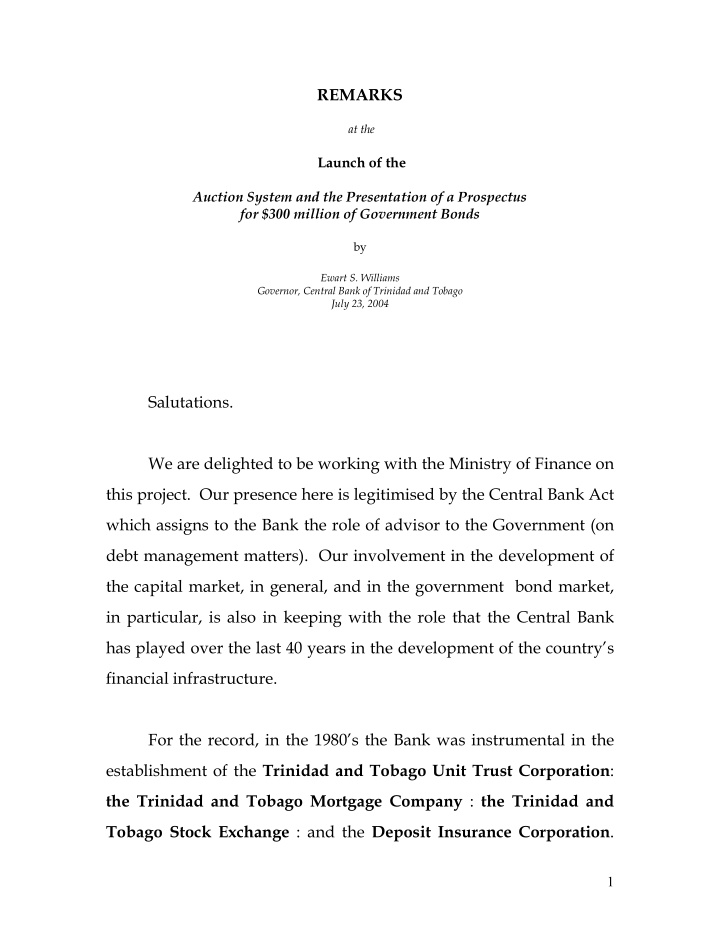



REMARKS at the Launch of the Auction System and the Presentation of a Prospectus for $300 million of Government Bonds by Ewart S. Williams Governor, Central Bank of Trinidad and Tobago July 23, 2004 Salutations. We are delighted to be working with the Ministry of Finance on this project. Our presence here is legitimised by the Central Bank Act which assigns to the Bank the role of advisor to the Government (on debt management matters). Our involvement in the development of the capital market, in general, and in the government bond market, in particular, is also in keeping with the role that the Central Bank has played over the last 40 years in the development of the country’s financial infrastructure. For the record, in the 1980’s the Bank was instrumental in the establishment of the Trinidad and Tobago Unit Trust Corporation : the Trinidad and Tobago Mortgage Company : the Trinidad and Tobago Stock Exchange : and the Deposit Insurance Corporation . 1
In the mid-1990’s we were involved with the birth of the Securities and Exchange Commission . More recently we have collaborated with the commercial banks in the creation of the Banking Services Ombudsman’s Office and with the banks and other stakeholders in the establishment of the Regional Credit Rating Agency . All these institutions are now major players in a capital market infrastructure, in which the government bond market is a most important component. Ladies and Gentlemen, the Trinidad and Tobago Government bond market is well developed in several aspects and unfortunately, deficient in others. On the positive side: ● There has been a fairly steady supply of bonds over the past several years. Including issues by state enterprises and public initiatives, public sector issues have averaged close to $3 billion a year between 2000 – 2003. ● Government bonds are a preferred investment. In fact with the traditional investors alone (the insurance companies, the NIB and the pension funds) there is normally a situation of excess demand . This will be exacerbated by demand from a growing number of mutual funds and securities firms. 2
● A third positive, is that the bond market has been able to generate tremendous confidence. Perhaps the best indicator, is the fact that the Government has been able to place fixed rate issues at maturities that extend up to 25 years : this is an accomplishment that few capital markets can match. The bottom line is that, given the country’s stable economic environment, the Government has no problems in raising resources from bond issues to finance expenditure. As for the deficiencies: ● There is little secondary trading and most institutions buy bonds to hold to maturity. ● A fairly large portion of bonds (more than 50 percent) carry special features such as floating rates and call options, which tend to fragment the market and limit the extent to which it could establish benchmarks. ● With underwriting being the predominant distribution mechanism in the primary market, the process of price determination is non-transparent. 3
All these factors create distortions and prevent our bond markets from making an optimal contribution to our capital market development. The launch that the Honourable Minister will announce this morning represents a decisive step to move the government bond market to the next level. On the face of it, the launch merely introduces a complete overhaul to the procedures for primary market issuance. In effect, however, it does more than that, it actually broadens the list of objectives that underlie government bond issuance. No longer is the government bond programme simply related to budget financing and debt management : in addition it will now be explicitly geared to fostering savings and providing economic information to financial markets. Ladies and Gentlemen, I think Minister Enill and his Ministry should be congratulated for this important step that is being initiated today . It is long overdue and it is a critical development if Trinidad and Tobago is to consolidate its position as the region’s paramount financial center. But this is only the first critical step in a much needed process of reform of the government bond market . Let’s keep in mind the broader objective. 4
Our aim is to create a government bond market that is liquid and transparent : one that emphasises market-based pricing : that encourages broad investor participation : establishes an efficient yield curve and fulfils its bench-marking function. To achieve these objectives we need to move beyond the auction mechanism. For example: (i) the auction needs to be supported by a published calendar of issuance for government bonds (including planned borrowings by state enterprises), with all the relevant information so that stakeholders are kept informed of supply and demand conditions; (ii) we would need to accelerate the introduction of the central electronic depository in order to improve the efficiency and speed of transactions and settlement ; and very importantly; (iii) the overhaul of the primary market needs to be followed by the development of a liquid secondary market. This last objective is going to be a somewhat more complicated exercise and will need a concerted public-private sector partnership. The public sector will need to provide the regulatory framework. A 5
critical aspect of this will be for the regulatory agencies (in particular the Central Bank and the SEC) to work with the financial institutions to agree and insist on standardised accounting practices and market valuation rules . The challenge for the private sector will be to provide a number of financial institutions that are prepared to “make a market”. These institutions would need to demonstrate the commitment, the technical skills and the capital backing and be prepared to go out and actively trade in government bonds. The Central Bank is prepared to do its part in achieving this reform : we will continue to work closely with the Government in this endeavour. I am sure the private sector will do its part. 6
Recommend
More recommend